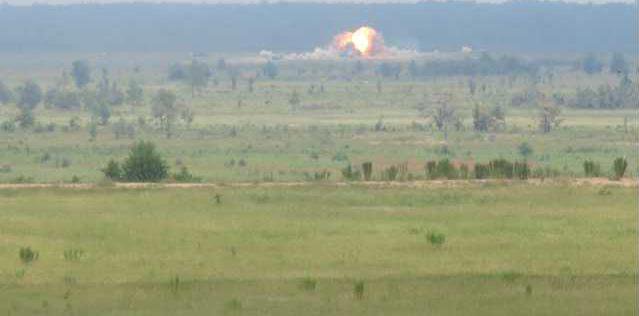A first-of-its-kind training exercise took place Wednesday at Fort Stewart’s Wright Army Airfield and an artillery range near Observation Point 1.
Soldiers with the 224th Military Intelligence (Aerial Exploitation) at Hunter Army Airfield launched an MQ-5B Hunter unmanned aircraft system from Wright Army Airfield. Then, using a laser targeting system, the UAS operator guided Air Force tactical aircraft to the identified target more than 4 miles away.
According to Fort Stewart public-affairs spokesman Kevin Larson, this was the first time Army UAS operators have used their laser targeting system in a joint training exercise.
“Today’s exercise between the Georgia Air National Guard and the 224th MI is proof of the versatility of the training capabilities here at Fort Stewart,” Larson said. “Not only can we fire every weapon in the Army’s arsenal here, we also have the capability to support dropping 500-pound bombs from Air Force A-10s and F-15s. Training like this is proof of the partnerships between the services and the installation.”
Marty Shelton, a strategic synchronization specialist with the contractor that supports the UAS project, CAS Group, Wyle Inc., said the Hunter is the oldest unmanned aircraft vehicle, having first been deployed in Kosovo in the mid-1990s. The retired Army combat medic said using Army unmanned aerial vehicles to identify the enemy with its special camera system, then track with a laser targeting system, is “like putting the hunting dog out in front of the hunter.” The MQ-5B Hunter points to the target so the Air Force can destroy it with their smart bombs.
Shelton said an operator-pilot and a camera operator fly and control the unmanned aircraft from ground-control stations. He said the major difference between the Air Force’s remote-controlled airplanes and the Army’s unmanned aircraft is the role in combat. He said the Air Force uses its RCAs for strategic planning, while the Army puts their UAVs into tactical use, including intelligence gathering, surveillance and reconnaissance. They also can serve a more direct combat role like the exercise they were doing Wednesday, he said.
At that time, Spc. Randy Royce was flying the aircraft while Sgt. Adam Kurth was operating the camera. First Sgt. Joseph Cuevas said they usually fly the Hunter at 6,000 to 8,000 feet and can identify and “lase” targets from up to 4 miles away, he said.
“This morning, we’ll be flying at around 7,000 feet,” Cuevas said. “There will be some A-10s and F-15s flying above us. We’ll hold off-target about 7,000 or 8,000 kilometers to identify the target. At that time, we’ll lase the target. The Air Force will then release their munitions off our laser.”
One of their unit’s newest operators is Pfc. Alicia Pia, who has been working with UAVs since last September. Although she describes her job as generally routine after a while, she said nonetheless it’s “pretty cool” when she tells people what she does in the Army. And even though operating a UAV is not the same as playing a video game, she said most people think it is.
Observers at OP 1 Wednesday watched the impact area several thousand meters away as they listened for the Air Force A-10s, then the F-15s.
The tactical aircraft could be heard long before they were seen. Just when it seemed the aircraft was turning in another direction, a burst of fire and cloud of smoke appeared on the impact area.
The smoke cloud already was turning into a pillow of gray-and-black smoke when the thunder of the 500-pound bomb finally was heard.
Lt. Col. Bob Noren, 165th Air Support Operation Squadron, Georgia Air National Guard in Savannah, praised the exercise. He said the A-10 aircraft were from Moody Air Force Base in Valdosta, while the F-15s were from Seymour Johnson Air Force Base in Goldsboro, North Carolina.
“We’re allowed to drop live, 500-pound munitions, working with the same ordnances we use downrange,” Noren said. “It’s really a matter of accuracy. We want to be able to discern exactly where the bad guys are.”
Cuevas summed up the day’s training by saying it was better to learn how to coordinate and work with other branches here at Fort Stewart than downrange.

